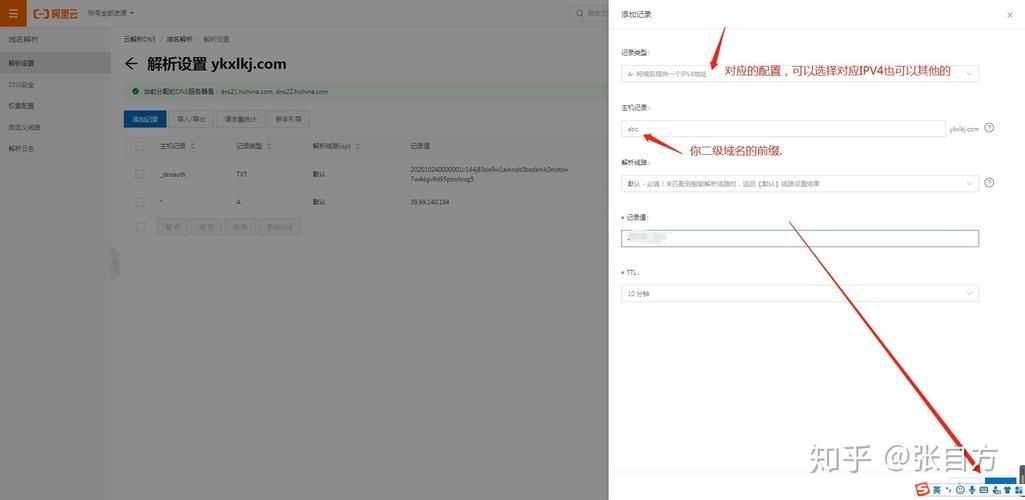本篇文章给大家谈谈nginx二级域名配置,以及nginx配置二级域名(多级域名)对应的知识点,文章可能有点长,但是希望大家可以阅读完,增长自己的知识,最重要的是希望对各位有所帮助,可以解决了您的问题,不要忘了收藏本站喔。
 nginx如何配置域名
nginx如何配置域名方法一:多个.conf方法(优点是灵活,缺点就是站点比较多配置起来麻烦)
这里以配置2个站点(2个域名)为例,n个站点可以相应增加调整,假设:
IP地址: 192.168.1.100
域名1 example1.com放在/www/example1
域名2 example2.com放在/www/example2

配置 nginx virtual hosting的基本思路和步骤如下:
把2个站点 example1.com, example2.com放到 nginx可以访问的目录/www/
给每个站点分别创建一个 nginx配置文件 example1.com.conf,example2.com.conf,并把配置文件放到/usr/local/nginx/vhosts/
然后在/usr/local/nginx/nginx.conf里面加一句 include把步骤2创建的配置文件全部包含进来(用*号)
重启 nginx
1、打开/usr/local/nginx/nginix.conf文件,在相应位置加入 include把以上2个文件包含进来

user www www;
worker_processes 1;
# main server error log
error_log/usr/local/nginx/log/nginx/error.log;
pid/usr/local/nginx/nginx.pid;
events{
worker_connections 51200;
}
# main server config
http{
include mime.types;
default_type application/octet-stream;
log_format main‘$remote_addr–$remote_user [$time_local]$request‘
‘”$status”$body_bytes_sent“$http_referer”‘
‘”$http_user_agent”“$http_x_forwarded_for”‘;
sendfile on;
#tcp_nopush on;
#keepalive_timeout 0;
keepalive_timeout 65;
gzip on;
server{
listen 80;
server_name _;
access_log/usr/local/nginx/log/nginx/access.log main;
server_name_in_redirect off;
location/{
root/usr/share/nginx/html;
index index.html;
}
}
#包含所有的虚拟主机的配置文件
include/usr/local/nginx/vhosts/*;
}
2、在/usr/local/nginx下创建 vhosts目录
mkdir/usr/local/nginx/vhosts
3、在/usr/local/nginx/vhosts/里创建一个名字为 example1.com.conf的文件,把以下内容拷进去
server{
listen 80;
server_name example1.com www. example1.com;
access_log/www/access_ example1.log main;
location/{
root/www/example1.com;
index index.php index.html index.htm;
}
error_page 500 502 503 504/50x.html;
location=/50x.html{
root/usr/share/nginx/html;
}
# pass the PHP scripts to FastCGI server listening on 127.0.0.1:9000
location~.php${
fastcgi_pass 127.0.0.1:9000;
fastcgi_index index.php;
fastcgi_param SCRIPT_FILENAME/www/example1.com/$fastcgi_script_name;
include fastcgi_params;
}
location~/.ht{
deny all;
}
}
3、在/usr/local/nginx/vhosts/里创建一个名字为 example2.com.conf的文件,把以下内容拷进去
server{
listen 80;
server_name example2.com www. example2.com;
access_log/www/access_ example1.log main;
location/{
root/www/example2.com;
index index.php index.html index.htm;
}
error_page 500 502 503 504/50x.html;
location=/50x.html{
root/usr/share/nginx/html;
}
# pass the PHP scripts to FastCGI server listening on 127.0.0.1:9000
location~.php${
fastcgi_pass 127.0.0.1:9000;
fastcgi_index index.php;
fastcgi_param SCRIPT_FILENAME/www/example2.com/$fastcgi_script_name;
include fastcgi_params;
}
location~/.ht{
deny all;
}
}
5、重启 Nginx
/etc/init.d/nginx restart
方法二:动态目录方法(优点是方便,每个域名对应一个文件夹,缺点是不灵活)
这个简单的方法比起为每一个域名建立一个 vhost.conf配置文件来讲,只需要在现有的配置文件中增加如下内容:
# Replace this port with the right one for your requirements
#根据你的需求改变此端口
listen 80;#could also be 1.2.3.4:80也可以是1.2.3.4:80的形式
# Multiple hostnames seperated by spaces. Replace these as well.
#多个主机名可以用空格隔开,当然这个信息也是需要按照你的需求而改变的。
server_name star.yourdomain.com*.yourdomain.com http://www.*.yourdomain.com/;
#Alternately: _*
#或者可以使用:_*(具体内容参见本维基其他页面)
root/PATH/TO/WEBROOT/$host;
error_page 404 http://yourdomain.com/errors/404.html;
access_log logs/star.yourdomain.com.access.log;
location/{
root/PATH/TO/WEBROOT/$host/;
index index.php;
}
# serve static files directly
#直接支持静态文件(从配置上看来不是直接支持啊)
location~* ^.+.(jpg|jpeg|gif|css|png|js|ico|html)${
access_log off;
expires 30d;
}
location~.php${
# By all means use a different server for the fcgi processes if you need to
#如果需要,你可以为不同的FCGI进程设置不同的服务信息
fastcgi_pass 127.0.0.1:YOURFCGIPORTHERE;
fastcgi_index index.php;
fastcgi_param SCRIPT_FILENAME/PATH/TO/WEBROOT/$host/$fastcgi_script_name;
fastcgi_param QUERY_STRING$query_string;
fastcgi_param REQUEST_METHOD$request_method;
fastcgi_param CONTENT_TYPE$content_type;
fastcgi_param CONTENT_LENGTH$content_length;
fastcgi_intercept_errors on;
}
location~/.ht{
deny all;
}
最后附另外一个二级域名匹配的方法
绑定域名
server_name*.abcd.com;
获取主机名
if($host~*(.*).(.*).(.*))
{
set$domain$1;
}
定义目录
root html/abc/$domain/;
location/
{
root html/abcd/$domain;
index index.html index.php;
配置服务器 —— Nginx添加多个二级子域名 --- 2018-06-26Nginx多文件配置二级子域名(推荐)
首先,在自己的域名控制台中添加解析,这里以添加blog前缀为例
我用的是万网,在 解析设置 中 添加解析
主机记录:你想要的二级域名
记录值:你的IP地址
保存后,我们就完成了第一步把子域名解析到我们的服务器上。
第二步:添加配置文件
进入nginx的 /conf 配置文件夹中,编辑 nginx.conf 文件
[root@iZ2844brz0xZ~]# cd/usr/local/nginx/conf/[root@iZ2844brz0xZ~]# vim nginx.conf
在 http 模块中添加如下语句
include/usr/local/nginx/conf/sites-enabled/*.conf;
告诉这个配置文件要去包含 /sites-enabled 目录下的所有以 .conf 结尾的配置文件。:wq 保存。
此时,我们新建一个 /sites-enabled 文件夹,并在其中添加 blog.***.com.conf 文件
[root@iZ2844brz0xZconf]# mkdir sites-enabled[root@iZ2844brz0xZsites-enabled]# vim blog.***.com.conf
在文件中添加
server{listen80;#监听端口server_name blog.***.com;#绑定域名root/usr/local/nginx/html/blog/;#网站根目录,建议使用绝对路径indexindex.phpindex.htmlindex.htm;#默认文件#添加对php的解析location~\.php${ fastcgi_pass127.0.0.1:9000; fastcgi_indexindex.php; fastcgi_param SCRIPT_FILENAME$document_root$fastcgi_script_name; include /usr/local/nginx/conf/fastcgi_params; }#添加错误页面,利于搜索引擎收录以及良好的用户体验error_page404/404.html; location/404.html{ root/usr/local/nginx/html/; } error_page500502503504/50x.html; location=/50x.html{
root/usr/local/nginx/html/; }}
内容可自行添加
Nginx单文件配置二级子域名
在 nginx.conf 文件的 server 模块中添加以下语句
if($host~*(\b(?!www\b)\w+)\.\w+\.\w+){ set$subdomain/$1;}location/{ root html$subdomain;indexindex.htmlindex.phpindex.htmindex;}
即可解析到对应文件夹
最后,重启nginx即可
[root@iZ2844brz0xZsites-enabled]#/usr/local/nginx/sbin/nginx-s reload
来自:https://blog.csdn.net/LBinin/article/details/70188752
nginx配置二级域名(多级域名)之前在v2看到毒鸡汤,很是喜欢,想着也部署到我的博客上来,域名就用二级域名 dujitang.flywill.cn,由于我的服务器是Nginx,于是就有了这篇配置二级域名的文章。
先谷歌了一下,得到的结果
这里用的是单文件配置的,很明显,这样不优雅。
我使用的是多文件配置,先看下配置文件
在 http结构中 include/etc/nginx/conf.d/*.conf;已经引入了该文件夹下所有以.conf文件结尾的文件
所以你要做的就是在该目录下建立新的二级域名的配置文件
然后重启nginx就搞定了。
新的配置文件只需要有 server级就行了,其他诸如 http、 event在主配置文件中写就可以了。
具体可以点击这里查看。
如何将顶级域名重定向到二级域名如果对于域名没有过多了解的人,会经常将 example.com和 www.example.com认定为相同的域名。但事实并非是如此, example.com为顶级域名, www.example.com为二级域名。有的人在上网时习惯性的输入 example.com进行访问,而有的人则选择带有 www前缀的二级域名,但是细心的人会发现,多数的知名网站都会将其重定向到带有 www的二级域名中,这也是符合我们的使用习惯的。从开发的角度来看,这两个域名会带来跨域的问题,所以我们应该在访问 example.com自动重定向到 www二级域名,可以减少不必要的问题。接下来我介绍一下应该如何进行配置,我以自己的域名 hesunfly.com为例进行介绍,使用的服务器软件为 Nginx。
登陆服务器,打开 Nginx的域名配置文件:
完成上面的配置后我们在浏览器输入 hesunfly.com就可以看到会自动重定向到 https://www.hesunfly.com下。可是如果用户使用 Https输入 https://hesunfly.com我们的重定向就不能正常使用了,所以接下来需要配置 Https下的重定向。
大功告成!其实也不复杂,但是自己在配置时也是踩了一些坑!
文章同步发布在我的个人博客中,传送门 Hesunfly Blog
END,本文到此结束,如果可以帮助到大家,还望关注本站哦!


